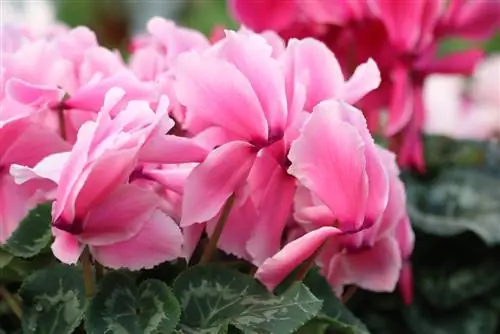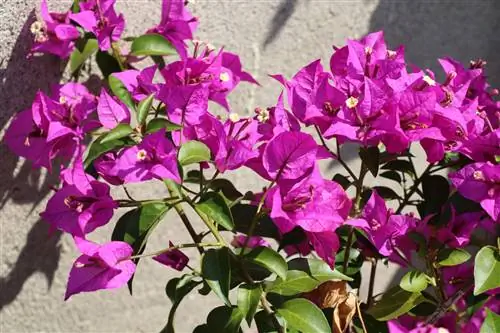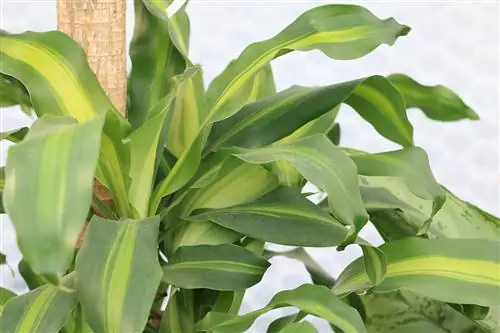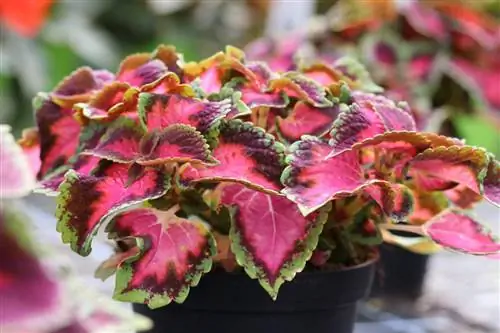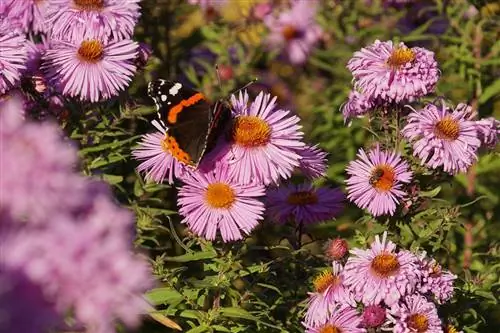- Author admin [email protected].
- Public 2023-12-17 03:39.
- Last modified 2025-01-24 12:45.
In autumn, the perennials with their pretty flowers are available in stores everywhere. After all, the distinctive cyclamen blooms during the winter months and is therefore popular as a houseplant. However, the indoor cyclamen (bot. Cyclamen persicum) cannot tolerate frost and therefore has to stay indoors. The situation is completely different with other, winter-hardy species of the genus, which can be easily planted in the garden.
Hardy species
The approximately 22 different species of the cyclamen plant genus mostly come from mild to warm regions - especially the Mediterranean, Turkey and Asia Minor - and are therefore not hardy. However, a few varieties defy the cold Central European winter, which is why they are suitable for planting in the garden. You can choose between the following three species, which can tolerate even very cold winters with temperatures down to minus 40 °C:
- European or summer cyclamen (bot. C. purpurascens): blooms between July and August, then sprouts again
- Wintergreen early spring cyclamen (bot. C. coum): small, flowering period between February and March, planting in autumn
- Ivy-leaved or autumn cyclamen (bot. C. hederifolium): flowering period between August and October, leaves appear after flowering
In addition, varieties are occasionally available in stores that are hardy down to around minus 10 to 20 degrees Celsius. These species can also be planted in the garden, but they definitely need winter protection. This group includes:
- Anatolian cyclamen (bot. C. cilicium): from Turkey, autumn blooming
- Amanus cyclamen (bot. C. pseudibericum): from Turkey, flowering period April to May
- Propeller cyclamen (bot. C. trochopteranthum): from southern Europe, flowering period February to March
- Cyclamen mirabile: from Turkey, autumn blooming
- C. parviflorum: from Turkey, smallest species of the genus, autumn-flowering
- C. intaminatum: from Turkey, up to ten centimeters high, autumn flowering
Please note that these species can freeze to death in very cold and snowy winters. This is particularly true for the propeller cyclamen, which is only frost-resistant down to minus 10 degrees Celsius. However, you can also care for the plants indoors at temperatures between 12 and a maximum of 18 degrees Celsius.
Non-hardy species
All other cyclamen species tolerate little or no frost and are therefore not suitable for outdoor cultivation in winter. This is especially true for popular varieties like these:
- Roman cyclamen (bot. C. persicum)
- Cyprus cyclamen (bot. C. persicum)
- Greek cyclamen (bot. C. graecum)
- Curly-leaved cyclamen (bot. C. repandum)
- African cyclamen (bot. C. africanum)
and others. Such plants should only be grown in pots and must remain indoors between September and May. Only in the summer months should you place the planters outdoors in a protected and partially shaded place.
Tip:
Keep your eyes open when buying: Just because the dealer advertises the plant as frost-resistant doesn't necessarily mean it's true. Some resourceful sellers sell non-hardy cyclamen as suitable for overwintering outdoors. However, the awakening follows quickly, because these plants can tolerate a maximum of minus five degrees Celsius - if at all - and freeze to death outside.
The best tips for wintering
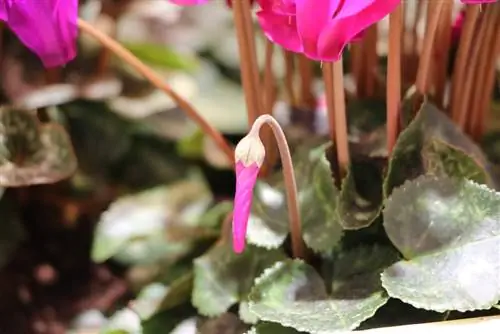
Regardless of whether they are hardy or not: with a few tricks, all cyclamen species can be easily brought through the winter so that you can enjoy the richly flowering plants for a long time. After all, the cold season has some pitfalls that need to be mastered.
Hardy species
Even if the hardy varieties are more or less frost-resistant depending on the type, they should still be protected from winter damage.
Protected location
All cyclamen species need a bright, but not directly sunny place in the garden that is protected from wind. It is best to plant the tubers under taller trees, where the plants will find the necessary protection.
Sink the tuber deep enough into the ground
Avoid placing the tubers too shallowly in the soil: they freeze easily in deep frost. At a planting depth of between five to ten centimeters, the sensitive tuber is well protected from condensation and cold.
Tip:
If cyclamen are grown in pots, they always belong in the house - even if they are a well-hardy species - so that they can overwinter frost-free. The reason for this is the small amount of soil in the planter, which freezes very quickly in frost and therefore offers no protection to the tubers.
Winter protection with brushwood and leaves
Protect the tubers from the cold with an additional protective layer about three to five centimeters thick:
- Twigs (spruce or fir branches)
- Compost
- or autumn leaves
Only cover the soil area in which the underground plant organs are located. The flowers, in turn, do not need any protection. The three very hardy cyclamen species generally only need protection as young plants (i.e. during the first two to three years) and in very cold winters; the other varieties should always be covered.
Avoid excessive moisture
Place the tubers where excess water - for example from rain or dew - cannot accumulate. In heavier soils, also ensure effective drainage so that the water can drain away. Otherwise, tuber rot can occur and the plants die.
Tip:
If in doubt, winter-hardy varieties can also be overwintered indoors. However, you should not put these species in the heated living room, but rather place them in a cool and bright place - for example, the bedroom, which is unheated for many people in winter, is ideal.
Non-hardy species
Overwintering the non-hardy cyclamen species, however, is a little trickier. The following tips will help the plants survive the cold season he althily and without pest infestation.
Choose a bright location
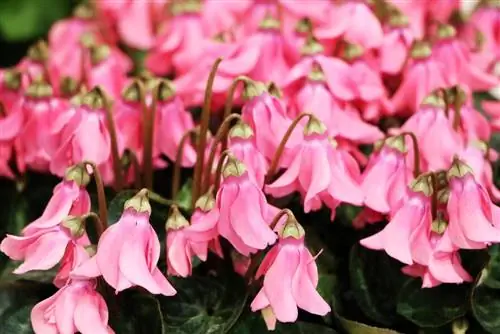
For cyclamens grown indoors, the same applies to the location as for garden cyclamens: the plants want to be bright, but not directly sunny. Stairwells are usually very suitable, but so is an (unheated) winter garden or your north-facing bedroom - provided there is not another tree or building in front of the window that would block the light.
Don't keep it too warm
The most important rule for overwintering a cyclamen is this: Do not place the plant warmer than 12 to a maximum of 18 degrees Celsius! The flowers can't tolerate frost, but they don't like it too warm either. The window sill in the living room is therefore the wrong place; instead, unheated or poorly heated rooms are better suited.
Watering moderately, avoid waterlogging
The cyclamen also needs water in winter, after all, it is in its blooming season. Therefore, water it moderately but regularly - the soil in the pot should then feel slightly moist, but not wet. Excess water should be able to drain into a planter or a saucer and be removed from there after 30 minutes at the latest. Always pour directly onto the soil or into the saucer - never from above!
Removing wilted flowers
The flowering period and the formation of seeds cost the plant a lot of energy. So that it can collect enough nutrients and energy in its tubers for new growth by spring, you should remove any dead flowers immediately. However, do not cut the shoots, but pull them off carefully.
Tip:
As a typical winter bloomer, the popular indoor cyclamen (bot. Cyclamen persicum) shows its flowers for a very long time between September and April, but takes a break during the summer months. You practically have to “oversummer” this species. This is best done in a semi-shady, not too warm place in the garden or on the balcony. The plant can stay here until autumn, but must be brought back in time before the first frost.

